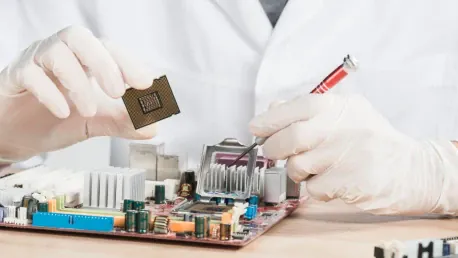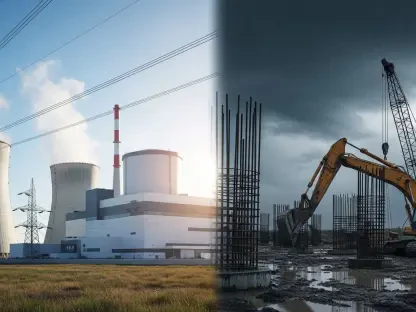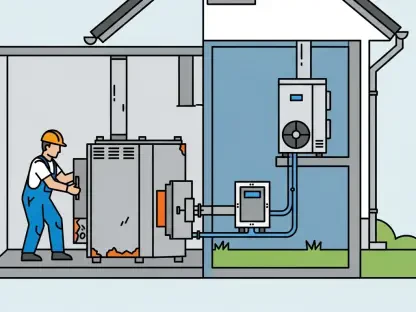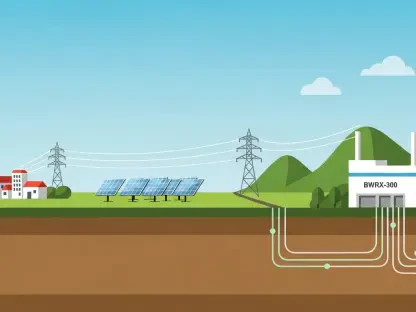The Department of Energy (DOE) has undertaken a crucial initiative to confront the escalating energy demands sparked by the burgeoning proliferation of microelectronics and artificial intelligence. By committing an investment of $179 million, the DOE is financing the establishment of three Microelectronics Science Research Centers. Among them is the highly esteemed SLAC National Accelerator Laboratory, which is charged with pioneering new technologies aimed at significantly enhancing energy efficiency.
The Ambitious Goals of the DOE Initiative
Addressing Energy Consumption in Modern Technology
The primary objective of this groundbreaking initiative is to develop next-generation microelectronics capable of managing the surging energy consumption demands linked to advancements in computing, medical devices, and scientific instruments. This effort focuses on creating energy-efficient technologies that also prove reliable in extreme environments, ultimately ensuring the sustainability of the exponential growth in energy demands driven by artificial intelligence and other modern applications. As conventional technology scales up, the consumption of electricity has become a pressing concern, necessitating innovative solutions to meet these demands sustainably.
The project aims at breaking through the limitations of current energy consumption models by leveraging cutting-edge research and interdisciplinary collaboration. Modern technology’s appetite for electricity expands rapidly as devices become more sophisticated. In the world of artificial intelligence, extensive computational requirements substantially increase the power demands, challenging the infrastructure and sustainability of current systems. By seeking to create microelectronics that perform more efficiently, while also operating in extreme conditions, the DOE envisions a smoother path toward the future of technology without compromising the planet’s resources.
SLAC’s Pivotal Role
SLAC National Accelerator Laboratory, considered a linchpin in this initiative, spearheads two pivotal projects within the ambit of the Microelectronics Energy Efficiency Research Center for Advanced Technologies (MEERCAT). Their role is not limited to these projects; instead, SLAC also collaborates on research efforts within the Extreme Lithography & Materials Innovation Center (ELMIC) and the Co-design & Heterogeneous Integration for Microelectronics in Extreme Environments (CHIME). These associations underscore SLAC’s critical contributions to the DOE’s vision of a future where energy efficiency meets technological advancements.
SLAC’s extensive experience and infrastructure uniquely position it to drive forward the objectives of MEERCAT, ELMIC, and CHIME. By bringing together specialists from diverse fields, SLAC ensures that the projects benefit from a holistic approach built on multidisciplinary competencies. Whether advancing novel microelectronic materials or pushing the boundaries of what is achievable in extreme environments, SLAC’s collaboration with other national laboratories and academic institutions helps lay a robust foundation for sustainable growth. This concerted effort promises significant strides in achieving the DOE’s ambitious goals.
Reimagining Microelectronics for Enhanced Efficiency
Overcoming the Limits of Conventional Miniaturization
The DOE has recognized that traditional methodologies employed for device miniaturization are nearing their feasible limits. Consequently, there is an urgent necessity to explore alternative approaches that balance the competing demands for heightened computing power and reduced energy consumption. The mission of MEERCAT, therefore, encompasses the design and discovery of new materials, devices, and system architectures that are pivotal to advancing computing and sensing capabilities. These advancements are essential not just for the DOE’s scientific mission but also for broader technological evolution.
Delving into novel materials and unconventional designs is critical to overcoming the barriers posed by current technologies reaching their physical limits. The process requires integrating insights from various scientific and engineering disciplines to formulate holistic solutions. By focusing on innovative approaches that transcend traditional boundaries, MEERCAT aspires to create microelectronics that redefine efficiency and performance metrics. This forward-thinking framework is essential for paving the way to more sustainable computing paradigms, essential in a world that increasingly relies on high-performance technologies.
The ESTEEM Project
Within the realm of MEERCAT, the project “Enabling Science for Transformative Energy-Efficient Microelectronics” (ESTEEM) stands out. Esteemed researcher Paul McIntyre from SLAC’s Stanford Synchrotron Radiation Lightsource leads it. ESTEEM focuses on the development of innovative methods in manufacturing, metrology, design, and simulation, aiming to foster the creation of energy-efficient microelectronics. The project’s extensive collaborative network includes premier institutions such as Stanford University, the Georgia Institute of Technology, Northwestern University, University of Tennessee, Knoxville, and University of Texas, San Antonio, ensuring a fusion of best practices and cutting-edge research.
This collaborative spirit is vital for the success of ESTEEM, bringing together experts from multiple disciplines to tackle the complex challenges of energy-efficient microelectronics. By pooling resources and knowledge, the project seeks to achieve breakthroughs that would be unattainable in isolation. ESTEEM’s holistic approach encompasses the entire lifecycle of microelectronic devices, from conceptual design to manufacturing and deployment, ensuring that energy efficiency becomes a cornerstone of modern technology. This project not only paves the way for scientific advancements but also sets a precedent for industry-wide practices, driving systemic improvement in energy consumption.
Brain-Inspired Computing
Emulating the Brain’s Energy Efficiency
One of the most riveting areas being explored by researchers involves drawing inspiration from the human brain’s exceptional energy efficiency. Modern computer configurations typically necessitate data traversing extensive wiring between separate logic and memory chips, an inherently energy-intensive process. To better emulate the brain’s efficiency, researchers propose integrating logic and memory functions into a single component or device. Such integration can considerably cut down on energy waste and boost performance, fostering the development of microelectronics that are not just more efficient but also capable of handling more complex tasks.
Simulating the brain’s efficiency in microelectronic devices presents a monumental challenge, demanding a rethinking of conventional computer architecture. Current designs rely heavily on separate logic and memory modules, creating significant inefficiencies in data transfer and processing. By merging these functions, akin to how the brain operates, scientists aim to create a new breed of microelectronics that transcends traditional limitations. This brain-inspired approach heralds a future where artificial intelligence and other high-demand applications are powered by devices that are both powerful and energy-efficient, reaping benefits across various sectors from healthcare to scientific research.
The Atoms-to-Algorithms Strategy
To realize this goal, an “atoms-to-algorithms strategy” is employed, requiring the coordination of physical processes over vast spatial and temporal scales and subsequent mapping of these processes onto software. This co-design methodology enables simultaneous progression in materials science, device design, and the development of ultrafast instruments, collectively optimizing the innovation process. The fusion of these elements lays the groundwork for crafting microelectronics that are not only efficient but also remarkably advanced, pushing the envelope of what’s technologically feasible.
This strategy fosters an integrated approach where every stage of the development process is interconnected, ensuring that advancements in one area benefit others. By coordinating physical and algorithmic processes meticulously, researchers can achieve a symphony of functionality that drives the efficiency of microelectronics to new heights. The atoms-to-algorithms framework represents a comprehensive roadmap, guiding the meticulous blending of materials, device architectures, and software. This holistic approach is vital for fostering innovation that is grounded in practicality, ensuring the advancements are applicable and sustainable in real-world scenarios.
Smarter Sensing Systems for Data Management
The Challenge of Data Overload
In today’s world, modern scientific instruments generate immense amounts of data at unprecedented speeds, outpacing traditional methods of data storage and analysis. To address this challenge, MEERCAT’s “Adaptive Ultra-Fast Energy-Efficient Intelligent Sensing Technologies” (AUREIS) project reimagines the data collection and analysis process. By focusing on smarter sensing systems that process and analyze raw data close to the sensor, the project aims to reduce the volume of data requiring transmission to computers, significantly easing the burden on data storage and transfer systems.
The endeavor to process data more efficiently near the source is essential in contending with the data deluge created by modern instruments. Traditional methods involve transmitting raw data to centralized systems for processing, which can be slow and energy-intensive. By shifting the analysis closer to where the data is generated, not only is energy conserved, but real-time insights become more achievable. This is especially critical in fields where timely data analysis can make substantial differences, such as in scientific research and medical diagnostics, enhancing overall system efficiency and efficacy.
Leveraging AI and Machine Learning
AUREIS is led by Angelo Dragone of SLAC and entails a collaboration with premier researchers from institutions such as Argonne National Laboratory, Brookhaven National Laboratory, Fermilab, Lawrence Berkeley National Laboratory, Lawrence Livermore National Laboratory, Stanford University, the University of Hawaii, Manoa, and GE Vernova. This project harnesses the power of AI and machine learning to support the development of adaptive, ultrafast, intelligent, and energy-efficient sensing technologies. Leveraging advanced AI algorithms and machine learning techniques, AUREIS intends to optimize data management, enhancing both the speed and energy efficiency of data processing.
The application of AI and machine learning in data management enables the development of more intuitive and responsive systems capable of learning and adapting to new data patterns. These sophisticated technologies can significantly streamline data processing, reducing the energy and computational resources needed. The synergy between AI, machine learning, and advanced sensing systems under the AUREIS project exemplifies how cutting-edge technology can be deployed to solve some of the most pressing challenges in data management today. This innovative approach ensures that the vast quantities of data generated are not just handled efficiently but also utilized optimally, advancing both scientific discovery and practical applications.
Microelectronics in Extreme Environments
Challenges of Extreme Conditions
Designing and operating microelectronics to function effectively in extreme conditions, such as extremely cold temperatures, high radiation levels, and intense magnetic fields, poses significant challenges. SLAC’s pioneering work in high-energy physics, quantum sensing, and ultrafast X-ray science provides a unique expertise essential for developing semiconductors, microelectronic circuits, and systems tailored for such demanding environments. This specialized knowledge is leveraged to push the boundaries of what is possible, ensuring that the technology can operate reliably even in the harshest conditions.
The demanding conditions necessitate the development of resilient materials and designs that can maintain functionality under stress. This task requires integrating knowledge from various scientific domains to create solutions that remain robust and reliable. Whether it’s sub-zero temperatures in space applications or high-radiation environments in nuclear facilities, the expertise fostered by SLAC in this field is invaluable. By addressing these specific challenges, the research not only advances scientific capabilities but also broadens the scope of microelectronics application, expanding the frontiers of human exploration and discovery.
The ELMIC’s Innovative Approaches
The Extreme Lithography & Materials Innovation Center (ELMIC) is at the forefront of integrating novel materials and processes, such as plasma-based nanofabrication and extreme ultraviolet (EUV) sources, to enhance microelectronics performance in extreme environments. One of the hallmark projects under ELMIC, “High Conversion Efficiency 2-micron Laser-Driven Sources for EUV Lithography and Plasma Science,” led by Lawrence Livermore National Laboratory, seeks to develop a novel plasma source producing light in the EUV wavelength. This is critical for more energy-efficient chip manufacturing, with SLAC’s expertise in target systems playing a crucial role in measuring and aligning these advancements.
ELMIC’s innovative approaches represent a significant leap forward in microelectronics technology. By advancing plasma-based nanofabrication and EUV sources, researchers are developing methods that not only enhance performance but also dramatically increase energy efficiency. This is particularly important in the manufacturing of next-generation chips, where precision and efficiency are paramount. These advancements promise to reduce production costs and environmental impact, making high-performance microelectronics more accessible and sustainable. The work done under ELMIC is setting new standards for what can be achieved in the field, laying the groundwork for future technological innovations.
CHIME’s Role in Next-Gen Technologies
Optimizing Technologies from Atomic Scale to Integrated Instruments
The Co-design & Heterogeneous Integration for Microelectronics in Extreme Environments (CHIME) center unites a plethora of projects aimed at optimizing next-generation technologies, ranging from the atomic scale to fully integrated instruments, particularly in challenging environments. A notable example is the “Single Photon Detectors Integrated with Cryogenic Electronics” (SPICE) project. Led by Fermilab, with collaboration from SLAC’s Lorenzo Rota, SPICE focuses on the development of advanced devices capable of detecting fundamental particles, enhancing our understanding of the universe through the integration of new materials, sensors, and circuits that operate at cryogenic temperatures.
The SPICE project epitomizes the integration of atomic-scale innovation with practical applications, demonstrating how cutting-edge technology can facilitate groundbreaking discoveries in fundamental science. By working at cryogenic temperatures, the project pushes the limits of what is possible in particle detection, providing unprecedented insights into the fundamental nature of the universe. This collaborative effort showcases the essential role of co-design in maximizing the potential of advanced materials and devices, ensuring that the technologies developed are not only innovative but also robust and reliable in practical applications.
Driving the Future of Microelectronics Research
The Department of Energy (DOE) has embarked on a vital mission to address the growing energy demands driven by the rapid expansion of microelectronics and artificial intelligence. Recognizing the urgency of this challenge, the DOE is investing a substantial $179 million to establish three specialized Microelectronics Science Research Centers. These centers are tasked with developing cutting-edge technologies to significantly improve energy efficiency. One of these centers, the renowned SLAC National Accelerator Laboratory, is dedicated to leading this innovative venture. SLAC’s role is pivotal as it aims to pioneer technological advancements that can revolutionize the field of energy efficiency, addressing the climbing energy requirements in the modern era. The initiative underscores the DOE’s commitment to fostering innovation and sustainable energy solutions, crucial for supporting the continued growth in the sectors of microelectronics and AI. This investment is not just about meeting current demands but also about anticipating future needs in an increasingly digital world.









